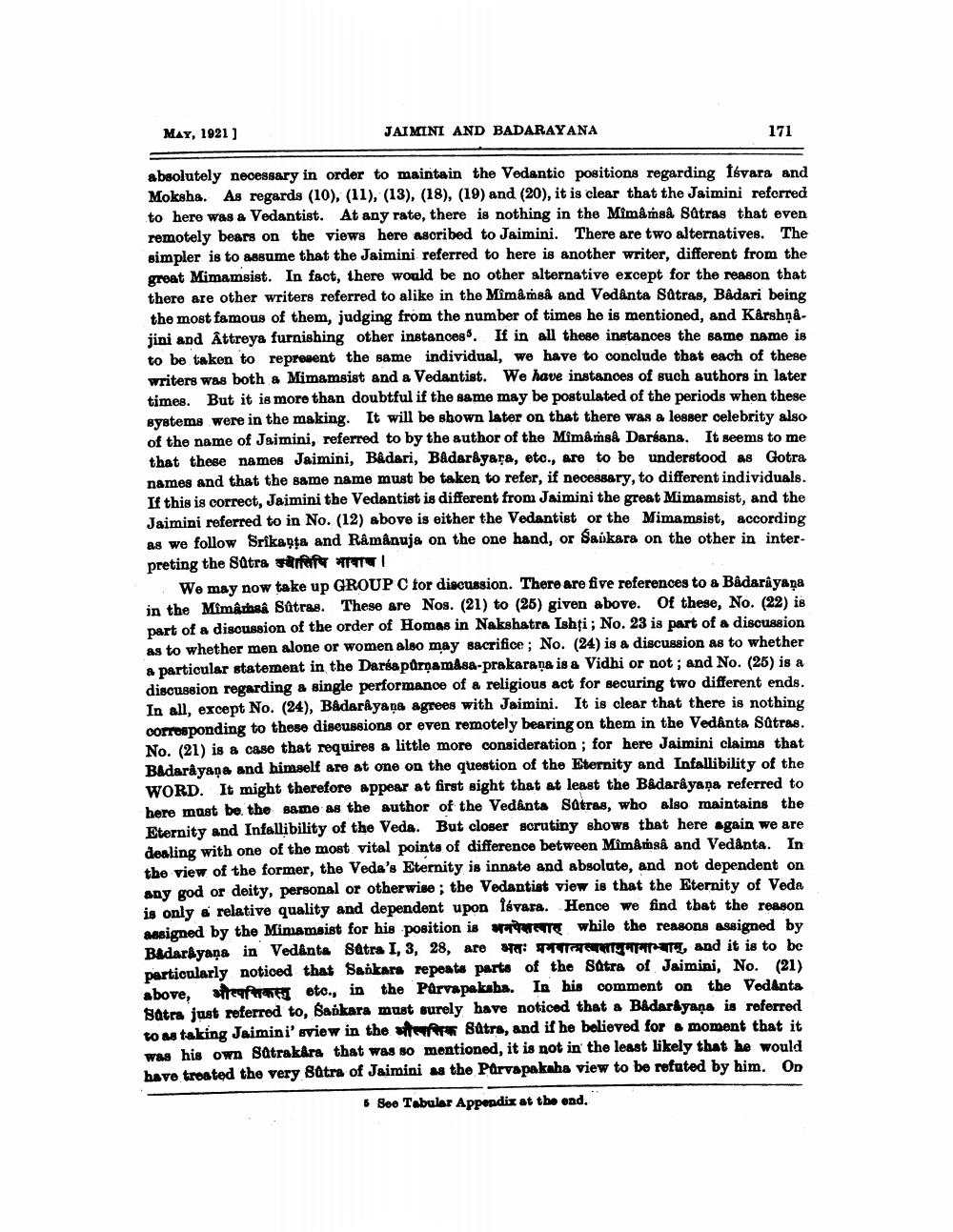________________
MAY, 1921)
JAIMINI AND BADARAYANA
171
absolutely necessary in order to maintain the Vedantic positions regarding Isvara and Moksha. As regards (10), (11), (13), (18), (19) and (20), it is clear that the Jaimini referred to here was a Vedantist. At any rate, there is nothing in the Mimârsa Sätras that even remotely bears on the views here ascribed to Jaimini. There are two alternatives. The simpler is to assume that the Jaimini referred to here is another writer, different from the great Mimamsist. In fact, there would be no other alternative except for the reason that there are other writers referred to alike in the Mimâmså and Vedanta Satras, Bâdari being the most famous of them, judging from the number of times he is mentioned, and Kårshội. jini and Attreya furnishing other instances. If in all these instances the same name is to be taken to represent the same individual, we have to conclude that each of these writers was both a Mimamsist and a Vedantist. We have instances of such authors in later times. But it is more than doubtful if the same may be postulated of the periods when these systems were in the making. It will be shown later on that there was a lesser celebrity also of the name of Jaimini, referred to by the author of the Mimâńsê Darsana. It seems to me that these names Jaimini, Badari, Badarêyara, eto., are to be understood as Gotra names and that the same name must be taken to refer, if necessary, to different individuals. If this is correct, Jaimini the Vedantist is different from Jaimini the great Mimamsist, and the Jaimini referred to in No. (12) above is either the Vedantist or the Mimamsist, according as we follow Srikanta and Râmânuja on the one hand, or Saúkara on the other in interpreting the Sätra refer
We may now take up GROUP C tor discussion. There are five references to a Badarîyapa in the Mimarosa Satras. These are Nos. (21) to (26) given above. Of these, No. (22) is part of a discussion of the order of Homas in Nakshatra Ishţi; No. 23 is part of a discussion as to whether men alone or women also may sacrifice; No. (24) is a discussion as to whether a particular statement in the Darsaparmamasa-prakarana is a Vidhi or not; and No. (25) is a discussion regarding a single performance of a religious act for securing two different ends. In all, except No. (24), Badarêyaņa agrees with Jaimini. It is clear that there is nothing corresponding to these discussions or even remotely bearing on them in the Vedanta Sutras. No. (21) is a case that requires a little more consideration ; for here Jaimini claims that BAdardyana and himself are at one on the question of the Eternity and Infallibility of the WORD. It might therefore appear at first sight that at least the Badarayaņa referred to here must be the same as the author of the Vedanta Satras, who also maintains the Eternity and Infallibility of the Veda. But closer sorutiny shows that here again we are dealing with one of the most vital points of difference between Mimánsâ and Vedanta. In the view of the former, the Veda's Eternity is innate and absolute, and not dependent on any god or deity, personal or otherwise ; tbe Vedantist view is that the Eternity of Veda is only a relative quality and dependent upon Isvara. Hence we find that the reason
signed by the Mimamsist for his position is S T while the reasons assigned by Badar yans in Vedanta Satra I, 3, 28, are sa: A T TITU, and it is to be particularly noticed that Sankara repeats parts of the Satra of Jaimini, No. (21) above, f i etc., in the Parvapakaba. In his comment on the Vodenta Satra just referred to, Sankara must surely have noticed that a Badar yana is referred to as taking Jaimini' sview in the
Sätra, and if he believed for a moment that it was his own Sätrakara that was so mentioned, it is not in the least likely that he would have treated the very Satra of Jaimini as the Parvapakahs view to be refuted by him. On
5 Soo Tabular Appendix at the end.




